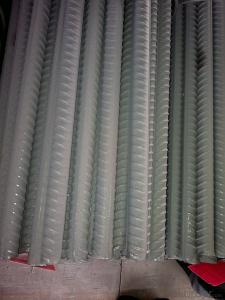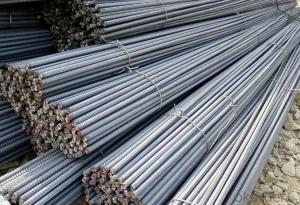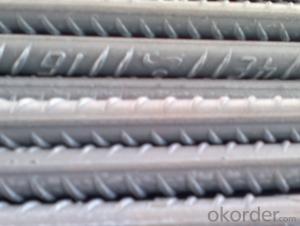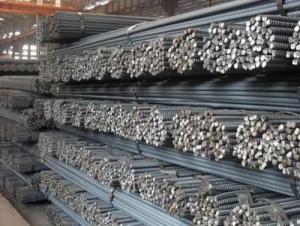Deformed Steel Bar, Iron Rods Bar for Construction/Concrete
- Loading Port:
- China main port
- Payment Terms:
- TT or LC
- Min Order Qty:
- 100 m.t.
- Supply Capability:
- 100000 m.t./month
OKorder Service Pledge
OKorder Financial Service
You Might Also Like
Product Description:
OKorder is offering Deformed Steel Bar, Iron Rods Bar for Construction/Concrete at great prices with worldwide shipping. Our supplier is a world-class manufacturer of steel, with our products utilized the world over. OKorder annually supplies products to African, South American and Asian markets. We provide quotations within 24 hours of receiving an inquiry and guarantee competitive prices.
Product Applications:
Deformed Steel Bar, Iron Rods Bar for Construction/Concrete are ideal for structural applications and are widely used in the construction of buildings and bridges, and the manufacturing, petrochemical, and transportation industries.
Product Advantages:
OKorder's Deformed Steel Bar, Iron Rods Bar for Construction/Concrete are durable, strong, and wide variety of sizes.
Main Product Features:
· Premium quality
· Prompt delivery & seaworthy packing (30 days after receiving deposit)
· Can be recycled and reused
· Mill test certification
· Professional Service
· Competitive pricing
Product Specifications:
Manufacture: Hot rolled
Grade: HRB335,HRB400,HRB500
Certificates: ISO, SGS, BV, CIQ
Length: 6m – 12m, as per customer request
Packaging: Export packing, nude packing, bundled
| DEFORMED BAR | |
| SIZE d(mm) | theoretical kg/m |
| 6 | 0.222 |
| 8 | 0.395 |
| 10 | 0.617 |
| 12 | 0.888 |
| 14 | 1.21 |
| 16 | 1.58 |
| 18 | 2 |
| 20 | 2.47 |
| 22 | 2.98 |
| 25 | 3.85 |
| 28 | 4.83 |
| 32 | 6.31 |
FAQ:
Q1: Why buy Materials & Equipment from OKorder.com?
A1: All products offered byOKorder.com are carefully selected from China's most reliable manufacturing enterprises. Through its ISO certifications, OKorder.com adheres to the highest standards and a commitment to supply chain safety and customer satisfaction.
Q2: How do we guarantee the quality of our products?
A2: We have established an advanced quality management system which conducts strict quality tests at every step, from raw materials to the final product. At the same time, we provide extensive follow-up service assurances as required.
Q3: How soon can we receive the product after purchase?
A3: Within three days of placing an order, we will arrange production. The normal sizes with the normal grade can be produced within one month. The specific shipping date is dependent upon international and government factors, the delivery to international main port about 45-60days.
Images:
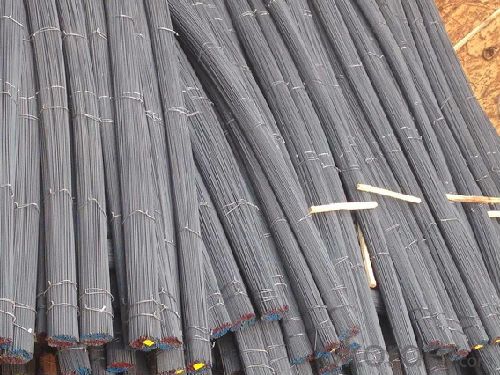
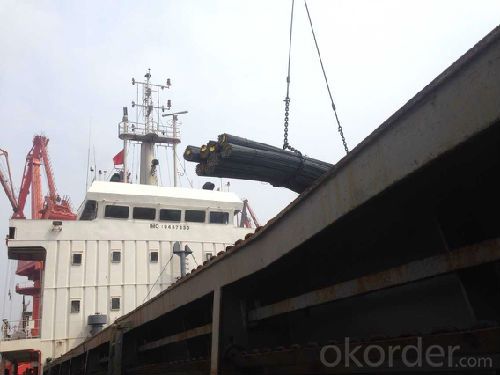
- Q:How do steel rebars affect the overall seismic performance of a structure?
- Steel rebars play a crucial role in enhancing the overall seismic performance of a structure. Seismic events such as earthquakes exert dynamic forces on buildings, causing them to vibrate and potentially collapse. However, the inclusion of steel rebars in concrete structures significantly improves their ability to withstand such forces and ensures the safety of the occupants. Firstly, steel rebars enhance the structural integrity of a building. By reinforcing the concrete, they increase its tensile strength, as concrete alone is weak in tension. During an earthquake, the rebars help distribute the dynamic forces throughout the structure, preventing the concentration of stress on specific areas. This redistribution of forces minimizes the risk of localized failures and ensures that the structure remains stable. Furthermore, steel rebars increase the ductility of the structure. Ductility refers to a material's ability to deform under stress without fracturing. During an earthquake, buildings experience significant lateral movements and deformations. Steel rebars, due to their high ductility, can elongate and stretch without breaking, absorbing and dissipating the seismic energy. This property allows the structure to withstand larger ground motions and reduces the possibility of sudden collapse. Additionally, steel rebars improve the overall resilience of a structure. Resilience refers to the ability of a building to quickly recover its functionality after an earthquake. By reinforcing the concrete, steel rebars contribute to the post-earthquake repairability of the structure. They ensure that the building maintains its load-carrying capacity even after suffering damages, which reduces downtime and allows for faster recovery. Moreover, steel rebars provide a warning sign of potential structural issues. During an earthquake, cracks may appear in the concrete, indicating areas of stress concentration. These cracks are often visible around the rebars, serving as an early indication of structural vulnerability. This visual warning allows for timely inspection and repair, preventing further damage and ensuring the long-term safety of the building. In conclusion, steel rebars play a vital role in enhancing the overall seismic performance of a structure. Their inclusion in concrete significantly improves the structural integrity, increases ductility, enhances resilience, and provides visual warnings of potential issues. By reinforcing the concrete, steel rebars ensure that buildings can withstand seismic forces, reducing the risk of collapse and ensuring the safety of occupants during earthquakes.
- Q:How do steel rebars affect the overall construction cost of commercial buildings?
- The overall construction cost of commercial buildings can be significantly affected by steel rebars. These rebars, commonly used to reinforce concrete structures, play a vital role in guaranteeing the building's strength and durability. To begin with, the cost of steel rebars can directly impact the construction budget. Their price varies depending on market conditions and availability, and since they are an essential component in construction, their cost can directly affect the project's expenses. Additionally, the installation of steel rebars adds to the construction cost by requiring skilled labor and specialized equipment. Skilled ironworkers are necessary to accurately place the rebars according to the structural design. The labor cost associated with this skilled work can constitute a significant portion of the overall construction budget. Furthermore, the cost is also influenced by the quantity and density of steel rebars used in the construction. The structural engineer determines the necessary amount and spacing of rebars based on the building's design and load-bearing capacities. In certain cases, more rebars are needed to meet specific safety standards or withstand higher levels of stress. This increased quantity of steel rebars inevitably leads to higher material and labor costs. However, it is essential to note that the use of steel rebars is indispensable in commercial buildings to ensure structural integrity and safety. Although they may contribute to the overall cost, their benefits outweigh the expenses. Steel rebars reinforce concrete, enhancing its tensile strength and ability to withstand external forces like earthquakes, wind, and heavy loads. Ultimately, this results in a longer lifespan for the building and reduces the likelihood of expensive repairs or structural failures in the future. In conclusion, the cost of steel rebars impacts the overall construction cost of commercial buildings due to the cost of the rebars themselves, the labor required for installation, and the quantity needed based on the structural design. Nevertheless, the use of steel rebars is crucial to guarantee the strength and durability of the building, reduce long-term maintenance costs, and ensure the safety of occupants.
- Q:What are the common mistakes to avoid when handling and storing steel rebars?
- To ensure the quality and longevity of steel rebars, it is crucial to steer clear of certain common mistakes. Here are some errors that should be sidestepped: 1. Inadequate storage conditions: The storage of steel rebars in damp or wet areas can result in corrosion and rust. To prevent moisture accumulation, it is vital to store them in a dry and well-ventilated space. 2. Insufficient support: To prevent bending or deformation, it is important to provide proper support when stacking rebars. Insufficient support can damage the rebars and compromise their structural integrity. 3. Improper lifting techniques: It is essential to employ appropriate lifting equipment and techniques when handling rebars. Using hooks or chains directly on the rebars can weaken and damage them. It is advisable to use lifting devices specifically designed for rebar handling. 4. Overloading: Avoid placing excessive weight on storage racks or platforms. Overloading can cause structural failure and pose a risk to workers. Always adhere to the manufacturer's guidelines for maximum weight capacity. 5. Lack of protection: Rebars should be shielded from moisture, dirt, and other contaminants. Wrapping them properly with plastic or waterproof covers can prevent corrosion and maintain their quality. 6. Improper transportation: During transportation, take care to secure the rebars adequately to prevent movement or damage. Using appropriate restraints and padding can prevent potential accidents or rebar displacement. 7. Mixing different grades: Do not mix rebars of different grades together, as they possess varying strength and performance characteristics. Mixing different grades can compromise the overall structural integrity of the construction project. 8. Neglecting quality control: Conduct regular quality checks on the rebars to ensure they meet the required specifications. Neglecting quality control can result in the use of substandard rebars, jeopardizing the safety and durability of the structure. By avoiding these common mistakes, construction professionals can guarantee the proper handling and storage of steel rebars, leading to safer and more durable structures.
- Q:How are steel rebars classified based on their yield strength?
- Steel rebars are classified based on their yield strength by assigning them grades or designations, such as Grade 40, Grade 60, or Grade 75. These grades indicate the minimum yield strength in thousands of pounds per square inch (ksi) that the rebars are able to withstand before permanent deformation occurs.
- Q:How do steel rebars provide reinforcement in concrete structures?
- Steel rebars provide reinforcement in concrete structures by adding strength and durability to the concrete. The rebars are embedded within the concrete, creating a bond that helps distribute and resist tensile forces. This reinforcement enhances the overall structural integrity, preventing cracking and increasing load-bearing capacity.
- Q:Can steel rebars be used in the construction of shopping centers?
- Yes, steel rebars can be used in the construction of shopping centers. Steel rebars are commonly used in reinforced concrete structures, including commercial buildings like shopping centers, as they provide strength, durability, and resistance to structural forces.
- Q:Can steel rebars be used in composite construction systems?
- Yes, steel rebars can be used in composite construction systems. Steel rebars are commonly used as reinforcement in composite structures to enhance their strength and durability. The rebars are embedded within the composite materials, such as concrete or fiber-reinforced polymers, to provide additional tensile strength and structural integrity. This combination of materials allows for a more efficient and cost-effective construction system.
- Q:Are there any environmental concerns related to steel rebars?
- Yes, there are some environmental concerns related to steel rebars. The production of steel involves the extraction of iron ore, which can lead to habitat destruction and deforestation. Additionally, the steel industry is known to be a significant contributor to greenhouse gas emissions. However, steel rebars are a common and necessary material in construction, and efforts are being made to mitigate these environmental impacts through recycling and energy-efficient production methods.
- Q:What are the maintenance requirements for steel rebars in a structure?
- To ensure the stability and longevity of a building, it is crucial to consider the maintenance requirements for steel rebars in its structure. Steel rebars, also referred to as reinforcing bars, are utilized to strengthen concrete structures and withstand tension forces. Here are some important maintenance requirements to bear in mind: 1. Conducting Visual Inspections: Qualified personnel with knowledge and experience in recognizing structural issues should regularly perform visual inspections to identify any signs of corrosion, cracks, or damage in the rebars. 2. Keeping the Rebars Clean: It is necessary to keep the rebars free from debris, dirt, or chemicals that could accelerate corrosion. Employing proper cleaning methods, such as mild detergents and water, is essential to maintain their condition. 3. Protecting Against Corrosion: Steel rebars are prone to corrosion, particularly in environments with high humidity, exposure to saltwater, or chemical pollutants. Applying protective coatings like epoxy or zinc can help prevent or delay corrosion, thereby increasing the lifespan of the rebars. 4. Prompt Repair or Replacement: In the event of severe corrosion, cracks, or damage to any rebars, it is crucial to promptly repair or replace them. Neglecting these issues can compromise the structural integrity of the building and pose safety hazards. 5. Continuous Monitoring: It is advisable to continuously monitor the condition of the rebars to detect any changes or deterioration over time. Advanced techniques such as ultrasonic testing or electrical potential measurements can be utilized to assess the rebars' integrity. 6. Ensuring Proper Drainage: The structure should have proper drainage systems in place to prevent water accumulation and reduce the risk of corrosion in the rebars. Well-designed and well-maintained gutters, downspouts, and waterproofing measures can minimize water exposure. 7. Establishing a Regular Maintenance Schedule: It is crucial to establish a regular maintenance schedule to systematically conduct all necessary inspections, cleaning, and repairs. This aids in early identification of potential issues and enables prompt corrective actions. By adhering to these maintenance requirements, the steel rebars in a structure can be preserved, contributing to the overall safety, durability, and longevity of the building. Regular maintenance not only prevents costly repairs but also ensures the necessary structural integrity for the safety of occupants and the longevity of the structure.
- Q:What are the guidelines for cutting and bending steel rebars on-site?
- To ensure safety and accuracy when cutting and bending steel rebars on-site, it is essential to adhere to specific guidelines. These guidelines play a crucial role in maintaining the structural integrity of the rebars. Here are some key considerations to keep in mind: 1. Prioritize safety: Before initiating any cutting or bending activities, it is imperative to prioritize safety. This involves wearing appropriate personal protective equipment (PPE) such as goggles, gloves, and steel-toe boots. Additionally, ensure that the work area is free from hazards and that all safety protocols are followed. 2. Utilize appropriate cutting tools: When cutting rebars, it is important to use high-quality cutting tools specifically designed for this purpose. Commonly used manual cutting tools include bolt cutters or hydraulic shears. It is crucial to ensure that the cutting tool is sharp and in good condition to achieve clean cuts. Avoid using torches or heat-based methods, as they can weaken the rebars. 3. Precise measurement and marking: Before cutting, it is essential to measure and mark the rebars accurately according to the required lengths. To ensure accuracy, utilize a measuring tape and a permanent marker. Double-check the measurements to avoid any mistakes that may result in wastage or improper reinforcement. 4. Employ proper bending tools: When bending rebars, it is vital to use appropriate bending tools or machines. These tools ensure accurate bending angles and minimize the risk of rebars breaking or cracking. Adhere to the bending specifications provided by the project engineer or local building codes to ensure compliance. 5. Familiarize with reinforcement requirements: Gain a thorough understanding of the reinforcement requirements by reviewing the project plans, drawings, and specifications. Different projects may have specific guidelines for cutting and bending rebars. It is crucial to adhere to these requirements to ensure correct installation and provide the necessary structural strength. 6. Maintain quality control: Regularly inspect the rebars during the cutting and bending process to verify that they meet the required standards. Look for any signs of damage, cracks, or substandard workmanship. Additionally, ensure that the rebars are appropriately sorted and stored to prevent mix-ups or confusion on-site. 7. Effective waste management: Implement proper waste management practices for the waste generated during the cutting and bending process. Collect and dispose of steel shavings or offcuts in designated containers to prevent injuries or accidents caused by sharp edges. In conclusion, adhering to these guidelines for cutting and bending steel rebars on-site will contribute to the safety, accuracy, and effectiveness of the reinforcement process. When in doubt or faced with specific project requirements, it is advisable to consult experienced professionals or the project engineer.
1. Manufacturer Overview |
|
|---|---|
| Location | |
| Year Established | |
| Annual Output Value | |
| Main Markets | |
| Company Certifications | |
2. Manufacturer Certificates |
|
|---|---|
| a) Certification Name | |
| Range | |
| Reference | |
| Validity Period | |
3. Manufacturer Capability |
|
|---|---|
| a)Trade Capacity | |
| Nearest Port | |
| Export Percentage | |
| No.of Employees in Trade Department | |
| Language Spoken: | |
| b)Factory Information | |
| Factory Size: | |
| No. of Production Lines | |
| Contract Manufacturing | |
| Product Price Range | |
Send your message to us
Deformed Steel Bar, Iron Rods Bar for Construction/Concrete
- Loading Port:
- China main port
- Payment Terms:
- TT or LC
- Min Order Qty:
- 100 m.t.
- Supply Capability:
- 100000 m.t./month
OKorder Service Pledge
OKorder Financial Service
Similar products
New products
Hot products
Hot Searches
Related keywords


